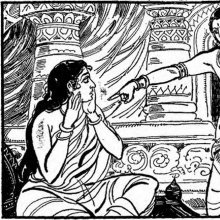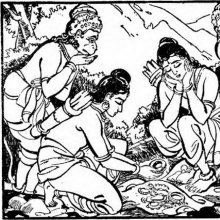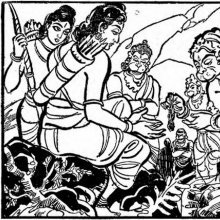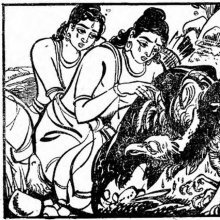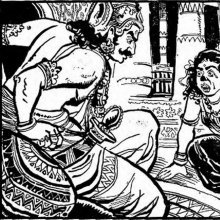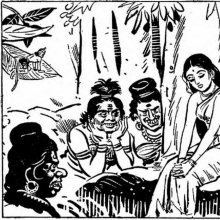Grief: 2 definitions
Introduction:
Grief means something in Hinduism, Sanskrit. If you want to know the exact meaning, history, etymology or English translation of this term then check out the descriptions on this page. Add your comment or reference to a book if you want to contribute to this summary article.
Images (photo gallery)
(+1 more images available)
In Hinduism
Natyashastra (theatrics and dramaturgy)
Source: Shodhganga: Elements of Art and Architecture in the Trtiyakhanda of the Visnudharmottarapurana (natya)1) Grief (expressions) are associated with Udyuta: one of the “seven movements of the head” (in Sanskrit Dramas), as conveyed through Āṅgikābhinaya: one of the four divisions of Abhinaya or “ways to convey or represent one’s emotion to others”, according to the Nāṭyaśāstra and the Viṣṇudharmottarapurāṇa, an ancient Sanskrit text which (being encyclopedic in nature) deals with a variety of cultural topics such as arts, architecture, music, grammar and astronomy.—The āṅgikābhinaya includes the histrionic representation of the limbs which is simply known as physical gestures. In the Viṣṇudharmottarapurāṇa, seven types of movements of the head are recorded. Udyuta denotes slowly shaken head shows grief, astonishment etc.
2) Grief is associated with Dolā-hasta: one of the thirteen Combined-hand Gestures (in Indian Dramas) (known as saṃyuktahastas).—According to the Śabdakalpadruma, dolā means a kind of swing playing stuff, generally stays in gardens and made with wood. When both of the hands are hanging downward in patāka posture it is called dolā. [...] In the Nāṭyaśāstra, the dolāhasta posture is said to indicate rush, grief, faint, fit of intoxication, emotion, illness and hit by weapon.

Natyashastra (नाट्यशास्त्र, nāṭyaśāstra) refers to both the ancient Indian tradition (shastra) of performing arts, (natya—theatrics, drama, dance, music), as well as the name of a Sanskrit work dealing with these subjects. It also teaches the rules for composing Dramatic plays (nataka), construction and performance of Theater, and Poetic works (kavya).
Ayurveda (science of life)
Source: International Research Journal of Ayurveda and Yoga: Role of Ayurveda in the Management of Manas Roga (Mental Disorders)Grief is denoted by the Sanskrit term Śoka and refers to one of the negative conditions of modern society.—Mental Health (according to Ayurveda) is brought about essentially as a result of unwholesome interaction between the individual and this environment. Epidemiological studies report prevalence rates for psychiatric disorders varying from 9.5 to 370/1000 population in India. [...]. In today’s metaphysical society, human life has become speedy, mechanized, and less effective and more centred, which contribute to more production of [e.g., Soka (grief)].

Āyurveda (आयुर्वेद, ayurveda) is a branch of Indian science dealing with medicine, herbalism, taxology, anatomy, surgery, alchemy and related topics. Traditional practice of Āyurveda in ancient India dates back to at least the first millenium BC. Literature is commonly written in Sanskrit using various poetic metres.
See also (Relevant definitions)
Full-text (+1047): Shoka, Vishoka, Socana, Shuca, Domanassa, Catapati, Hridroga, Hridayagranthi, Shokatura, Arara, Samtapa, Hricchoka, Udvega, Haha, Socati, Shokabhanga, Avida, Hayahaya, Manyu, Shokakarshita.
Relevant text
Search found 306 books and stories containing Grief; (plurals include: Grieves). You can also click to the full overview containing English textual excerpts. Below are direct links for the most relevant articles:
Mundaka Upanishad with Shankara’s Commentary (by S. Sitarama Sastri)
Verse 3.1.2 < [Mundaka III, Khanda I]
Verse 3.2.9 < [Mundaka III, Khanda II]
Verse 3.1.3 < [Mundaka III, Khanda I]
Brahma Sutras (Ramanuja) (by George Thibaut)
Sutra 1.3.4 < [First Adhyaya, Third Pada]
Sutra 1.3.33 < [First Adhyaya, Third Pada]
Summary statement as to the way in which different scriptural texts are to reconciled < [First Adhyaya, First Pada]
Dhammapada (Illustrated) (by Ven. Weagoda Sarada Maha Thero)
Verse 15 - The Story of Cundasūkarika < [Chapter 1 - Yamaka Vagga (Twin Verses)]
Verse 18 - The Story of Sumanādevi < [Chapter 1 - Yamaka Vagga (Twin Verses)]
Verse 367 - The Story Of The Brāhmin Who Offered Alms Food To The Buddha < [Chapter 25 - Bhikkhu Vagga (The Monk)]
Mahabharata (English) (by Kisari Mohan Ganguli)
Section XXIX < [Putradarsana Parva]
Section CCXV < [Markandeya-Samasya Parva]
Section CCCXXXI < [Mokshadharma Parva]
Ramayana of Valmiki (by Hari Prasad Shastri)
Chapter 41 - The whole world grieves for Prince Rama < [Book 2 - Ayodhya-kanda]
Chapter 27 - Rama describes Prasravana < [Book 4 - Kishkindha-kanda]
Chapter 62 - The king is overcome with grief < [Book 2 - Ayodhya-kanda]
Tiruvaymoli (Thiruvaimozhi): English translation (by S. Satyamurthi Ayyangar)
Pasuram 1.6.1 < [Section 6 - Sixth Tiruvaymoli (Parivatu il icanai)]
Pasuram 1.7.10 < [Section 7 - Seventh Tiruvaymoli (Piravittuar ara)]
Pasuram 2.1.3 < [Section 1 - First Tiruvaymoli (Vayum tirai)]
Related products
